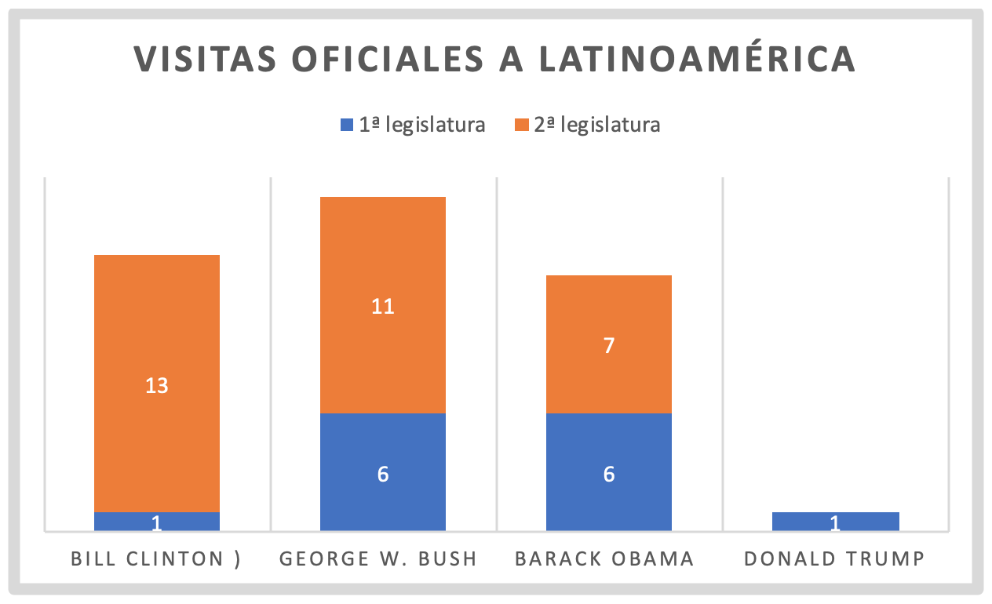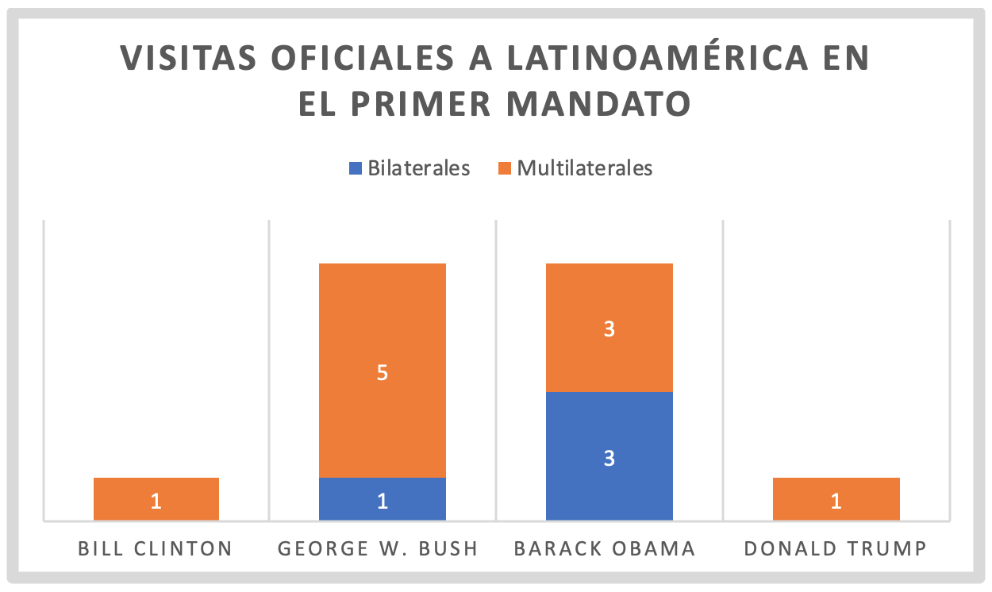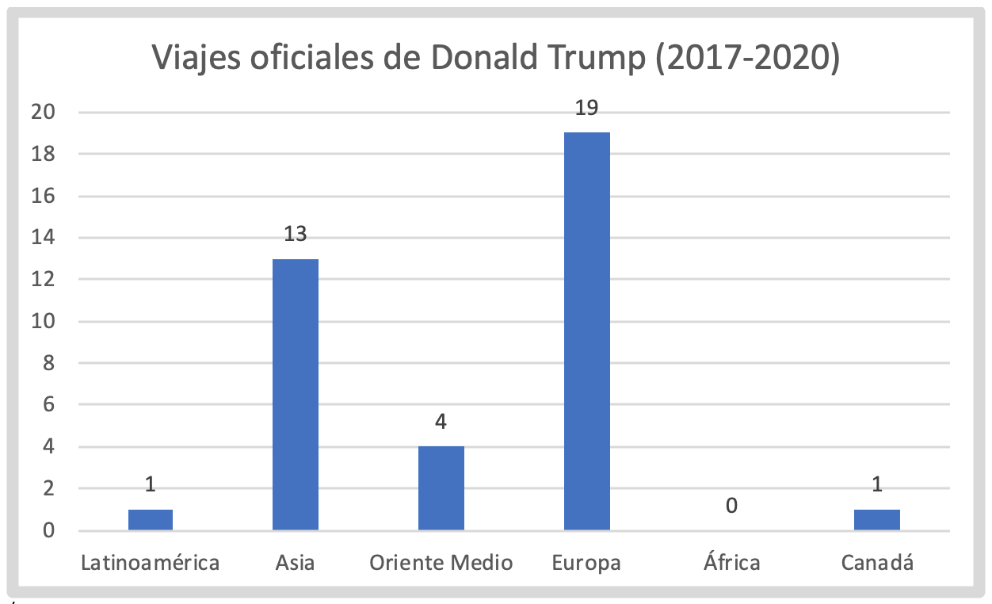The current president made only one visit, also at the framework of the G-20, compared to the six that Bush and Obama made in their first four years.
International travel does not tell the whole story about a president's foreign policy, but it does give some clues. As president, Donald Trump has only travelled once to Latin America, and then only because the G20 summit he was attending was being held in Argentina. It is not that Trump has not dealt with the region - of course, Venezuela policy has been very present in his management- but the fact that he has not made the effort to travel to other countries on the continent reflects the more unilateral character of his policy, which is not very focused on gaining sympathy among his peers.
![signature in Mexico in 2018 of the free trade agreement between the three North American countries [department of State, USA]. signature in Mexico in 2018 of the free trade agreement between the three North American countries [department of State, USA].](/documents/16800098/0/viajes-trump-blog.jpg/157ee6c8-c573-2e22-6911-3ae54fe8a0a8?t=1621883760733&imagePreview=1)
▲ signature in Mexico in 2018 of the free trade agreement between the three North American countries [department of State, USA].
article / Miguel García-Miguel
With only one visit visit to the region, the US president is the one who has made the fewest official visits since Clinton's first term in office, who also visited the region only once. In contrast, Bush and Obama paid more attention to the neighbouring territory, both with six visits in their first term. Trump focused his diplomatic campaign on Asia and Europe and reserved Latin American affairs for visits by the region's presidents to the White House or his Mar-a-Lago resort.
In reality, the Trump administration spent time on Latin American issues, taking positions more quickly than the Obama administration, as the worsening problem in Venezuela required defining actions. At the same time, Trump has discussed regional issues with Latin American presidents during their visits to the US. There has not, however, been an effort at multilateralism or empathy, going to his meeting in their home countries to deal with their problems there.
Clinton: Haiti
The Democratic president made only one visit to the region during his first term in office: visit . refund After the Uphold Democracy operation to bring Jean-Bertrand Aristide to power, on 31 March 1995 Bill Clinton travelled to Haiti for the transition ceremony organised by the United Nations. The operation had consisted of a military intervention by the United States, Poland and Argentina, with UN approval, to overthrow the military board that had forcibly deposed the democratically elected Aristide. During his second term, Clinton paid more attention to regional affairs, with thirteen visits.
Bush: free trade agreements
Bush made his first presidential trip to neighbouring Mexico, where he met with then President Fox to discuss a range of issues. Mexico paid attention to the US government's attention attention to Mexican immigrants, but the two presidents also discussed the functioning of the North American Free Trade Agreement (NAFTA), which came into force in 1994, and joint efforts in the fight against drug trafficking. The US president had the opportunity to visit Mexico three more times during his first term in office for the purpose of attend multilateral meetings. Specifically, in March 2002, he attended the lecture International Meeting on Financing for the development, organised by the United Nations and which resulted in the Monterrey Consensus; Bush also took the opportunity to meet again with the Mexican president. In October of the same year he attended the APEC (Asia-Pacific Economic Cooperation) summit, which that year was held in the Mexican enclave of Los Cabos. Finally, he set foot on Mexican soil once again to attend the Special Summit of the Americas held in Monterrey in 2004.
During his first term in office, Bush pushed for the negotiation of new free trade agreements with several American countries, which was the hallmark of his administration's policy towards the Western Hemisphere. framework As part of this policy, he travelled to Peru and El Salvador on 23 and 24 March 2002. agreement In Peru, he met with the President of Peru and the Presidents of Colombia, Bolivia and Ecuador, in order to reach an agreement to renew the ATPA (Andean Trade Promotion Act), by which the US granted tariff freedom on a wide range of exports from these countries. The matter was finally resolved with the enactment in October of the same year of the ATPDEA (Andean Trade Promotion and Drug Eradication Act), which maintained tariff freedoms in compensation for the fight against drug trafficking, in an attempt to develop the region economically in order to create alternatives to cocaine production. Finally, in the case of El Salvador, he met with the Central American presidents to discuss the possibility of a Free Trade Agreement with the region (known in English as CAFTA) in exchange for a strengthening of security in the areas of the fight against drug trafficking and terrorism. The treaty was ratified three years later by the US congress . Bush revisited Latin America up to eleven times during his second term.

Graph 1. Own elaboration with data of Office of the Historian
Obama: two Summits of the Americas
Obama began his tour of diplomatic visits to Latin America with attendance to the Fifth Summit of the Americas, held in Port-au-Prince (Trinidad and Tobago). The Summit brought together all the leaders of the sovereign countries of the Americas, with the exception of Cuba, and was aimed at coordinating efforts to recover from the recent crisis of 2008, with mentions of the importance of environmental and energy sustainability. Obama returned to attend in 2012 to the VI Summit of the Americas held this time in Cartagena de Indias (Colombia). No representatives from Ecuador or Nicaragua attended this summit in protest at the exclusion of Cuba to date. Neither the President of Haiti nor Venezuelan President Hugo Chávez attended, citing medical reasons. At the summit, the issues of Economics and security were once again discussed, with the war on drugs and organised crime being of particular relevance, as well as the development of environmental policies. He also took advantage of this visit to announce, together with Juan Manuel Santos, the effective entrance of the Free Trade Agreement between Colombia and the US, negotiated by the Bush Administration and ratified after some delay by the US congress . The Democratic president also had the opportunity to visit the region on the occasion of the G-20 meeting in Mexico, meeting , but this time the main focus of topic was on solutions to curb the European debt crisis.
In terms of bilateral meetings, Obama undertook a diplomatic tour of Brazil, Chile and El Salvador between 19 and 23 March 2010, meeting with their respective presidents. He used the occasion to resume relations with the Brazilian left that had governed the country since 2002, to reiterate his economic and political alliance with Chile, and to announce a $200 million fund to strengthen security in Central America. During his second term in office, he made up to seven visits, including the resumption of diplomatic relations with Cuba, which had been paused since the triumph of the Revolution.
Trump: T-MEC
Donald Trump only visited Latin America on one occasion to attend meeting the G-20, a meeting that was not even regional, held in Buenos Aires in December 2018. Among the various agreements reached were the reform of the World Trade Organisation and the commitment of the attendees to implement the measures adopted at the Paris agreement , with the exception of the US, since the president had already reiterated his determination to withdraw from the agreement. Taking advantage of the visit, he signed the T-MEC (Treaty between Mexico, the United States and Canada, the new name for the renewed NAFTA, the renegotiation of which Trump had demanded) and met with the Chinese president in the context of the trade war. Trump, on the other hand, did not attend the VIII Summit of the Americas held in Peru in April 2018; the trip, which was also supposed to take him to Colombia, was cancelled at the last minute because the US president preferred to remain in Washington in the face of a possible escalation of the Syrian crisis.
The reason for the few visits to the region has been that Trump has directed his diplomatic campaign towards Europe, Asia and to a lesser extent the Middle East, in the context of the trade war with China and the loss of power on the US international stage.

Graph 2. Own elaboration with data of Office of the Historian
Only one trip, but monitoring of the region
Despite having hardly travelled to the rest of the continent, the Republican candidate has paid attention to the region's affairs, but without leaving Washington, as up to seven Latin American presidents have visited the White House. The main focus of the meetings has been the economic development and the reinforcement of security, as usual. Depending on the reality of each country, the meetings revolved more around the possibility of future trade agreements, the fight against drugs and organised crime, preventing the flow of illegal immigration to the United States, and the search to strengthen political alliances. Although the US government website does not list it as an official visit , Donald Trump also met at the White House in February 2020 with Juan Guaidó, recognised as president in charge of Venezuela.
Precisely, if there has been a common topic to all these meetings, it has been the status economic and political crisis in Venezuela. Trump has sought allies in the region to encircle and put pressure on Maduro's government, which is not only an example of continuous human rights violations, but also destabilises the region. The ironclad civil service examination to the regime served Donald Trump as propaganda to gain popularity and try to save the Latino vote in the November 3 elections, and that had its award at least in the state of Florida.

Graph 3. Own elaboration with data of Office of the Historian